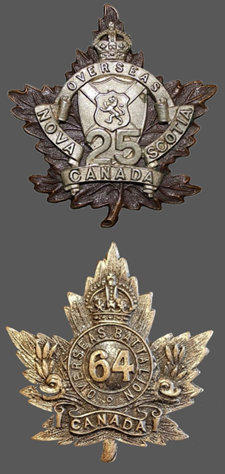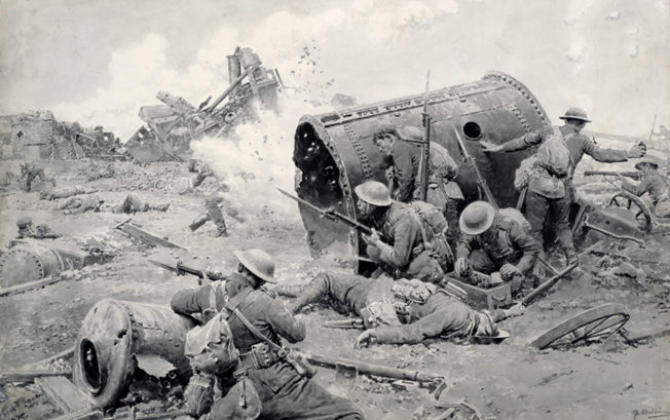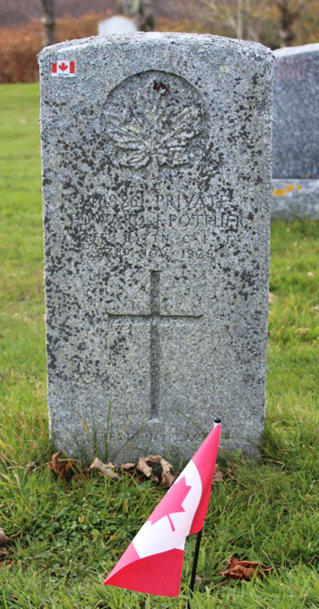
copyright © Wartime Heritage Association
Website hosting courtesy of Register.com - a web.com company
Wartime Heritage
ASSOCIATION
Remembering World War I
Yarmouth Connections
Name:
Edward Joseph Pothier
Service Number:
469261
Rank:
Private
Service:
64th Battalion, 25th Battalion,
Canadian Expeditionary Forces
Awards:
British War Medal 1914-1920,
Victory Medal 1914-1919, 1 Gold Bar
Date of Birth:
May 12, 1896
Place of Birth:
Yarmouth, Yarmouth Co., Nova Scotia
Date of Enlistment:
August 27, 1915
Place of Enlistment:
Sussex, New Brunswick
Age at Enlistment:
19
Address at Enlistment:
Yarmouth, Yarmouth Co., Nova Scotia
Height:
5 feet, 7 ½ inches
Complexion:
Fair
Eye Colour:
Hazel
Hair Colour:
Brown
Occupation:
Dry Goods Clerk, Salesman
Marital Status:
Single
Religion:
Roman Catholic
Next of Kin:
E. Pothier (Father) Yarmouth, Nova Scotia
Date of Discharge:
July 12, 1918
Age:
22
Date of Death:
November 23, 1929
Age:
33
Cemetery:
Our Lady of Calvary Roman Catholic Cemetery, Yarmouth, Nova Scotia
Edward Joseph Pothier was the son of Eugene Agapit Pothier (1859-1922) and Marie (Amirault) Pothier
(-1897) of Wedgeport, Yarmouth County, Nova Scotia, and the brother of Mary Evelena (Pothier)
Chisolm (1894-1975), Joseph Alfred Pothier (1897-1990), Mary Pothier (1911-2004) and Margaret
Marie Pothier. Edward’s father remarried Elsie Jean (d’Entremont) Pothier (1873-1954) after his
mother’s death.
Prior to WWI, Edward worked as a clerk in Yarmouth. After enlisting in August 1915, and training in
Canada he sailed to England from Halifax aboard the SS Adriatic on March 31, 1916.
He was briefly transferred to the 12th Battalion on June 24, 1916, en route to Shorncliffe in
Folkestone, Kent at the coast to be assigned to the Canadian 25th Battalion on June 29, 1916. Then,
he crossed the English Channel to join his Battalion in the field in France.
Edward was wounded by gunshot to his right arm at Courcelette on September 18, 1916. The Battle of
Courcelette, or the Battle of Flers-Courcelette, was part of the Somme offensive. The Battle was
fought from September 15-22, 1916. It resulted in thousands of battlefield casualties, but also
signalled the start of new thinking in military tactics that would eventually solve the riddle of the
trenches and help turn the tide of the war. Tanks were used in battle for the first time during the
Battle of Courcelette as well as the creeping artillery barrage.
From the field, he was initially transferred to a hospital in Boulogne, France, to be transferred back to
England for treatment and recovery. He was transferred to England aboard the Belgian ship Jan
Breydel on September 19, 1916, and admitted to the Metropolitan Hospital in Kingsland Road in
London, England the next day on September 20, 1916. On November 14, 1916 he was transferred to
the Canadian Convalescent Hospital at Hillingdon House in Uxbridge, Middlesex, England and
discharged from hospital in March 1917.
Edward returned to Canada onboard the Hospital Ship SS Letitia from Liverpool, England on March 12,
1917. He was admitted to the Pine Hill Convalescent Hospital in March and was released as an
outpatient for a time to convalesce at home in Yarmouth.
He did however return to Pine Hill on September 23, 1917, and was transferred to the Camp Hill
Military Hospital from October 25 to November 13, 1917. It was determined on December 1, 1917,
that he should be admitted to the sanatorium for treatment and recovery of the tuberculosis. Edward
was in the city on December 6, 1917.
Edward was wounded in the right eye by flying glass during the Halifax Explosion in the city on
December 6th. Penetrating eye injuries were extraordinarily prevalent in the Halifax Explosion
because of flying glass shards. The smoke cloud of the ignited SS Mont Blanc in the harbour drew men,
women, and children to their windows, not knowing that minutes later the vessel would explode –
shattering essentially every window in the city.
Edward was released from convalescence to his home, and discharged from the military on July 12,
1918, but he never fully recovered from all his injuries and illness suffered while serving in the
Canadian Infantry Corps.
He settled into a residence on Kempt Street in
Yarmouth. Edward found employment working as a
street car conductor on the Main Street line until
1928 when the line shut down. Edward died
November 23, 1929, in his home town of Yarmouth.
His death was attributed to complications of multiple
injuries sustained from duty during his service.
Edward’s funeral was held at the St. Ambrose
Cathedral in Yarmouth on November 25, 1929, and he
is interred at the Our Lady of Calvary Roman Catholic
Cemetery in Yarmouth, Nova Scotia.
Edward Joseph Pothier



The Capture of the Sugar Refinery at Courcelette by the Canadians on September 15, 1916, painted by Fortunino
Matania, Beaverbrook Collection of War Art



- World War I - Menu
- WWI Stories and Articles
- Photos - Yarmouth Soldiers
- Selection of World War I Songs
- WWI Casualties of Yarmouth, NS
- Those Who Served - Yarmouth, NS
- WWI Casualties Digby Co. NS
- WWI Casualties Shelburne Co. NS
- Merchant Mariners (1915) Yarmouth, NS
- Canadian Forestry Corps - Non Yarmouth Birth/Residence Enlistments
- US Draft Registry - Yarmouth NS Born


- World War II - Menu
- WWII Stories and Articles
- Telegraphist Air Gunners
- WWII Casualties of Nova Scotia
- US Casualties with NS Connection
- Far East/Pacific Casualties with NS Connection
- Merchant Navy Casualties Nova Scotia
- Nova Scotia WWII Casualties Holten Canadian War Cemetery
- D-Day Casualties - Nova Scotia
- CANLOAN Program Casualties - Nova Scotia
- Battle of the Bulge Casualties - Nova Scotia
- WWII Casualties Yarmouth NS
- Yarmouth Casualties - RCAF RAF Canadian Army WWII
- Yarmouth Co., Marriages WWII
- Casualties Non-Born/Residents with Connection to Yarmouth Co., Nova Scotia.
- WWII Casualties Digby Co., NS
- Non-Nova Scotian WWII Casualties Buried in Nova Scotia
- WWII RCAF Casualties Aged 16-18
- Brothers/Sisters Who Served - World War II














